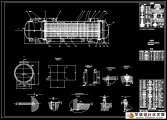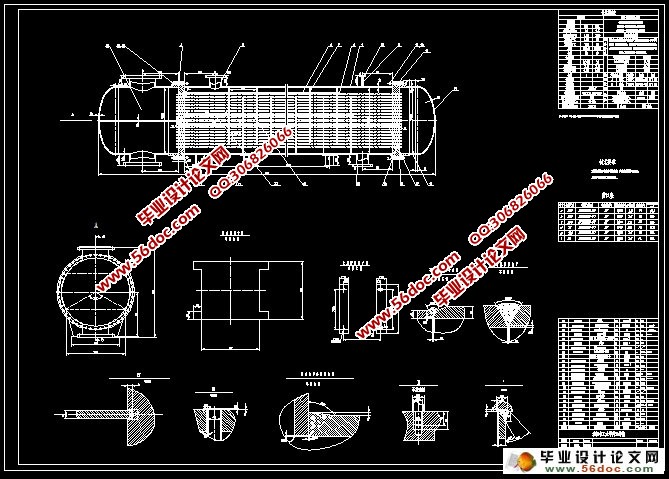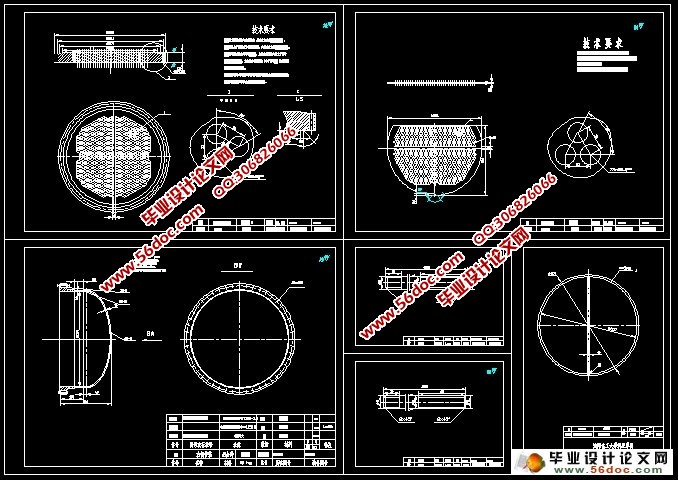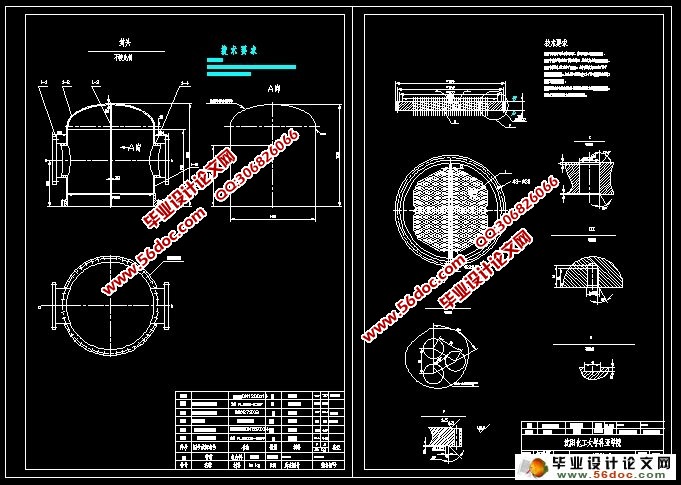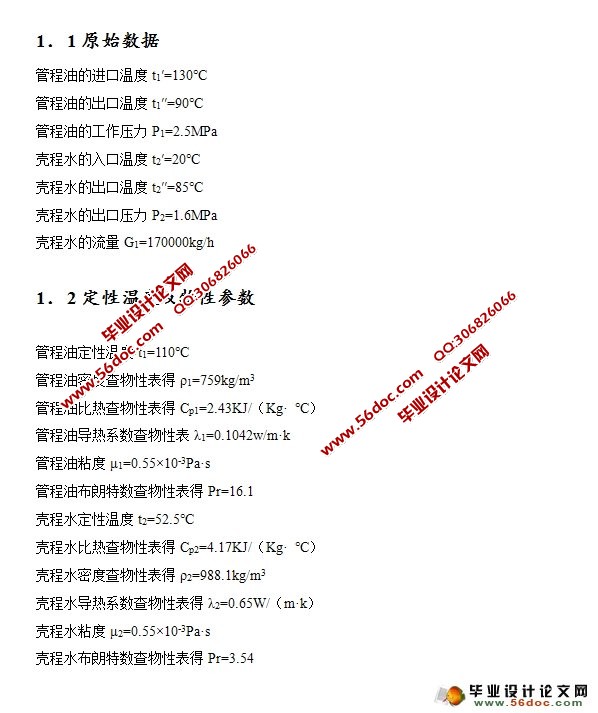流量为170t/h双管程固定管板式换热器(含CAD零件装配图)(设计说明书10600字,CAD图纸9张)
摘要
在不同温度的流体间传递热能的装置成为热交换器,简称为换热器。换热器是化工、交通、动力、石油、冶金国防等工业部门重要工艺设备之一。由于物料的性质、要求各不相同,换热器的种类很多,根据使用场合,使用目的有所不同。了解各种换热器的特点,根据工艺要求正确选用适当类型的换热器很重要。按照热量交换的方式不同,分为间壁式换热器、直接接触式换热器、蓄热式换热器三种。化工生产中绝大多数情况下不允许冷、热两流体在传热过程中发生混合,所以,间壁式换热器的应用最广泛,在换热器中至少要有两种温度不同的流体,一种流体的温度较高,放出热量;另一流体温度较低,吸收热量。换热器在动力、制冷、石油、食品、化工等等行业中都有广泛的应用,而且他们是上述这些行业的通用设备,并有着十分重要的部位。固定管板式换热器是管壳式换热器的一种典型结构,也是目前应用最广泛的一种换热器。固定管板式化热器的优点为结构简单,成本低、选材广、适应性强、耐压性强、方便清洗、管子损坏时便于堵管或更换,在各工业部门应用最为广泛。这种换热器使用于壳侧介质清洁且不宜结垢,并能进行清洗管束,壳程两侧温差不大或者温差较大但壳侧压力不高的场合。换热设备在石油化工、炼油以及在其他工业中使用广泛,它适用于冷凝、冷却、蒸发和废热回收等等方面。
列管式换热器分为U型管换热器和固定管板式换热器。U型管换热器结构特点是只有一块管板,换热管为U型,管子的两端固定在同一块板上,其管程至少为两程。U型管换热器的优点是:只有一块管板,结构简单,密封面少,运行可靠;管件清洗方便,管束可以抽出。缺点是管板利用率较低,管内清洗困难,管束内程管间距大,壳程易短路,内程管子坏了无法更换,所以报废率高。固定管板式换热器主要是由封头、管板、换热管、简体、管箱、法兰及折流板等组成,管班上两端分别固定着管束,简体和管板之间是刚性连接在一起,相互之间无相对移动,换热器结构简单、造价低、制造方便,在相同直径的壳体内可排列安装较多的换热管,并且每个换热管都可单独进行管内清洗或更换,但是管外清洗比较困难。因此,固定管板式换热器更适用于不易结垢的壳程流体清洁,而冷热流体温差不太大的管程常用清洗的场合不太适用。
固定管板式换热器的设计包括:流体设计、结构设计、热力设计和强度设计。在本次设计中进行了对物料及热量衡算,并对换热器整体机构进行计算和对换热器的基本附件进行选择和设计,最后绘出非标零件图和装配图。其中课题设计以强度校核和结构设计为主要设计内容。热力计算是指根据使用单位提出的基本要求,合理选择运行参数,并根据传热学的知识进行传热计算。
关键字:换热器,固定管板,壳体,封头
Abstract
In different temperature of liu medical transfer heat device become a heat exchanger, heat exchanger for short.Heat exchanger is chemical industry, transportation, power, petroleum, metallurgy, national defense industry one of the important technological equipment.Due to the nature of the material, requirements vary, there are many kinds of heat exchanger, according to the using situation, using low is different.To understand the characteristics of all kinds of heat exchanger, according to the technological requirements it is very important to correctly choose the right type of heat exchanger.According to the heat exchange in a different way, divided into recuperative heat exchanger, direct contact heat exchanger, three kinds of regenerative heat exchanger.Chemical production in the vast majority of cases are not allowed to cold and hot fluid in the process of heat transfer in hybrid, so, the most widely used, recuperative heat exchanger in the heat exchanger should have at least two different fluid temperature, the temperature of a fluid is higher, gives off heat;Another fluid temperature is low, absorption of heat.Heat exchanger in power, refrigeration, petroleum, food, chemical industry and so on are widely used in industry, second they are these industry general equipment, and has a very important part.Fixed tube plate heat exchanger is a kind of typical structure of tube and shell heat exchanger, a heat exchanger is currently the most widely used.Fixed tube plate heat exchanger of advantages as simple structure, low cost, wide material selection, strong adaptability, strong pressure resistance, convenient cleaning and pipe damage to facilitate tube jam or replaced, the most widely used in various industry departments.This kind of heat exchanger used in shell side of the media should not be clean and scaling, and can be washed, on both sides of the shell side shell temperature difference is not big or temperature difference is bigger but the occasion of the lateral pressure is not high.Heat exchange equipment in petrochemical, refining, and widely used in other industries, it is suitable for cooling, evaporation and condensation, waste heat recovery, etc.
Shell and tube heat exchanger is divided into U tube heat exchanger and fixed tube plate heat exchanger.U tube heat exchanger structure characteristics is only a piece of tube plate, heat exchange tube for U, at both ends of the tube are fixed on the same piece of plate, the monitor for at least two process.The advantages of the U tube heat exchanger is: only a piece of tube plate, structure is simple, sealing surface, less reliable operation;Fitting convenient cleaning, tube bundle can be pulled out.Defect is low utilization rate of tube sheet, tube cleaning is difficult, the distance between pipe bundle in cheng, shell Cheng Yi short circuit, the process pipe is broken can't change, so the scrap rate is high.Fixed tube plate heat exchanger is mainly composed of head, tube plate, heat exchange tube, simplified, pipe, flanges and baffle plate, etc, were fixed by bundle on both ends of the tube in the class, simplified and tube plate is rigid connection between together, no relative movement between each other, heat exchanger has simple structure, low cost, easy fabrication, inside the shell of the same diameter can be arranged to install more heat exchange tube, and each heat exchange tube can separate for pipe cleaning or replacement, but outside the pipe cleaning more difficult.Therefore, fixed tube plate heat exchanger is more suitable for not easy scaling of shell side fluid cleaning, and cold and hot fluid temperature difference is not too big tube side commonly used cleaning occasions don't apply.
Fixed tube plate heat exchanger design includes: fluid design, structure design, thermal design and strength design.In the design of material and heat balance, and a calculation is made of heat exchanger overall mechanism and basic attachments for selection and design of heat exchanger, the final draw non-standard parts drawing and assembly drawing.With intensity and structure design of the project design among them as the main design content.Thermodynamic calculation is according to put forward the basic requirement of units used, the reasonable selection operation parameters, and according to the knowledge of heat transfer, heat transfer calculation.
Key words: heat exchanger, fixed tubesheet and shell, head
目 录
第一章工艺计算说明书 1
1.1 原始数据 1
1.2 定性温度及物性参数 1
1.3 传热量与油流量 2
1.4 有效平均温差计算 2
1.5 管程换热系数计算 3
1.6 结构的初步设计 3
1.7 壳程换热系数计算 4
1.8 传热系数计算 5
1.9 管外壁热流密度计算 5
第二章换热器零部件的工业结构设计 6
2.1 换热管材料及规格的选择和根数的确定 6
2.2 布管方式的选择 6
2.3 筒体内径的确定 6
2.4 筒体壁厚的确定 7
2.5 封头形式的确定 7
2.6 管箱短节壁厚计算 8
2.7 容器法兰的选择 8
第三章换热器的强度设计及校核 10
3.1 筒的计算 10
3.2 对于延长部分兼作法兰的管板的计算 11
3.3 假定管板厚度的计算 13
3.4 值的计算 15
3.5 法兰厚度的计算 15
3.6 法兰力矩的组合 16
3.6.1 只有壳程设计压力Ps,而管程设计压力Pt=0,不计膨胀节变形差(即r=0) 16
3.6.2 只有壳程设计压力,而管程设计压力Pt=0,并且计入膨胀变形差 17
3.6.3 只有管程设计压力Pt,而壳程设计压力Ps=0,不计膨胀节变形差 19
3.6.4 只有管程设计压力Pt,而壳程设计压力Ps=0,同时计入膨胀变形差 20
3.6.5 由管板计算厚度来确定管板的实际厚度 21
3.7 是否安装膨胀节的确定 21
3.8 折流板尺寸的确定 21
3.9 各管控接管及其法兰的确定 22
3.10 设备法兰的选择 24
3.11 拉杆和定距管的确定 25
3.12 开孔补强计算a孔DN=mm(GB150-1998 项目8.1) 26
3.13 筒体管箱耐压试验的应力校核的计算 28
3.14 支座的选择及应力校核 29
3.14.1 支座的选择 29
3.14.2 鞍座的应力校核 29
参考文献 34
致谢 35
|
